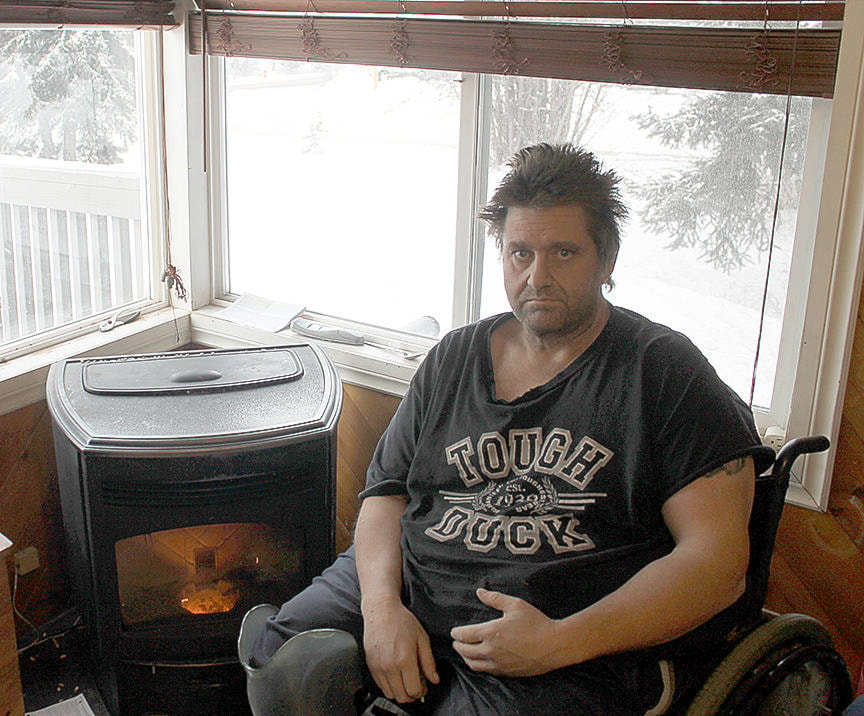Burns Lake resident Brian Hanson was confined to a wheelchair following a traffic accident in 1997. Then, in 2006 his right leg was amputated after an infection inside the leg became severe. For the last decade recurring sores and infections - a result of small bruises that worsen - have flared up and when they become serious he goes back and forth to a hospital in Kelowna where he receives proper care.
Usually he spends about three months in the hospital there. Last year his condition was so bad he had to be there for eight months.
Those trips down south take him away from the town he loves and calls home, but he just can’t get the same care in Burns Lake.
“I don’t want to move because of my health,” he told Lakes District News. “I don’t think I should have to. I pay a lot of money for my extended health considering I’m on a very small budget.”
The 49-year-old Hanson needs his bandages changed daily. However, the nurses can come to his house only on Monday, Wednesday and Friday.
“Just because there aren’t enough nurses. They’re completely strapped. I get really good help when they can get here.”
Occasionally, when the infections get particularly bad he needs treatment with a VAC (vacuum-assisted closure) machine, which involves putting a piece of foam inside a sore and then applying suction from an attached pump to keep the wound clean and to keep fresh blood circulating.
“The VAC is such a simple tool. My wound care nurse in Kelowna trained my wife Shelley before she passed away how to do it, and my buddy Shawn. And neither of them are nurses or doctors or whatever and they could do it no problem.”
It costs about $200 a day to rent and use it at home, Hanson said.
But he can’t receive treatment with that device in Burns Lake.
“My medical won’t cover it if I don’t have a nurse,” he said. “And then the nurses won’t do it. I’m not saying they didn’t want to do it but it’s not viable for them to do it because it’s only me. But if they had the VAC here I know for a fact three other people in town here would be on that VAC and healed up a lot faster. More people would use it if they had it.”
Hanson also can’t receive wound treatment here using Dakin’s solution, a mix of bleach, water and baking soda that he has prepared by himself in the past when he couldn’t get it from the hospital.
“They won’t use it on me here. So my infections continued to get worse and worse.”
Instead, local nurses have used mesalt gauze to disinfect his wounds.
“I have used it, but it doesn’t work for me. When I get an infection it’s really bad and mesalt won’t fix it.”
The constraints on health care in this area even come down to the kind of bandages Hanson needs, for which he pays about $300 a month on top of what the hospital pays.
“But then ‘we can’t use this bandage because we don’t use that brand’ or ‘this is the brand we use and we have to make due,’” he said about the response from hospital staff.
In addressing Hanson’s situation, Northern Health said several factors affect services in a given community.
“Availability of skilled staff can be one of those factors. With certain services or procedures there’s a need for our staff to have the right training or be able to maintain their skills or competencies and they do that by performing those skills regularly,” said Eryn Collins, acting Regional Manager of Public Affairs & Media Relations with Northern Health.
“It can [also] depend on the demand for those services and whether there’s enough demand to provide the care regularly.”
Collins explained that there are plans to bring more nurses to Burns Lake and that Northern Health is always actively recruiting more, including “exploring providing wound VAC care. Part of that exploration will be to ensure that staff has requisite training and be able to maintain competencies in providing that care.”
It was too soon to say when VAC care is expected to be available here, she added.
John Rustad, MLA for Nechako Lakes said he wishes the health care available from facilities in the region could better meet the needs of people like Hanson.
“Finding professionals, attracting them to live in Burns Lake, Houston, Fort St James or any other community, and attracting the kind of specialization that is required is always a challenge,” he said.
“I hope that Northern Health is working closely with the local mayor and council on approaches to attract these kind of professionals to the community.”
For years Hanson has been on disability insurance and in his spare time rebuilds snowmobile motors as a hobby with friends.
As he stroked his black Springer Spaniel Charlie, he stressed that he doesn’t blame anyone for his situation. In fact, he thinks the healthcare professionals in Burns Lake are doing a great job.
“I met a wound care nurse that’s been coming here and I heard she’s staying. That’s awesome. And she’s very good. I don’t want to move but if things keep getting worse, I’ve got to go to where I can get better healthcare. That would suck because I love this town. It has helped me so much. I can’t even imagine leaving this town.”
